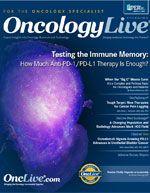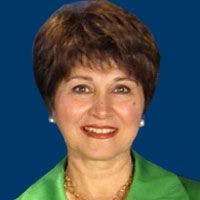Publication
Article
Oncology Live®
A Changing Population and Radiology Advances Mark HCC Field
Author(s):
Although it has been nearly 10 years since a new systemic drug has been approved for the treatment of patients with hepatocellular carcinoma, the field is changing rapidly due to new therapies for a prime underlying cause of the disease and advances in interventional radiology.
Riccardo Lencioni, MD
Although it has been nearly 10 years since a new systemic drug has been approved for the treatment of patients with hepatocellular carcinoma (HCC), the field is changing rapidly due to new therapies for a prime underlying cause of the disease and advances in interventional radiology.
That was the picture painted by HCC experts during a wide-ranging OncLive Peer Exchange® panel discussion entitled “Update on Treatment of Advanced Liver Cancer.” The program brought together experts in medical oncology, hepatology, and radiology who stressed the necessity of cooperation among specialists in their fields due to the complex nature of managing patients with HCC.
Riccardo Lencioni, MD, noted there is a “broad spectrum” of options for treating patients with HCC. “Sometimes we may have the feeling that there are competitors like surgery versus ablation, chemoembolization versus sorafenib [Nexavar],” he said.
“… In reality, when it comes to discussing individual patients, there is much more synergy and complementarity rather than competition among these different options. So this is the key for the management of HCC—personalized decisions.”
There are so many “gray zones between the different types of therapy” that specialists should participate in multi disciplinary team meetings, said moderator Ghassan K. Abou-Alfa, MD.
Ghassan K. Abou-Alfa, MD
“For the general community oncologist, they maybe see a handful of patients with liver cancer a year,” observed Richard S. Finn, MD. “… I think that it really behooves them to have a patient seen at a large transplant-based multidisciplinary setting. Even if the patient ends up coming back to them for care, the optimal approach would probably be developed in that setting, and it’s certainly a way to get them access to clinical trials.”
Finn, a translational researcher, also noted a frustrating lack of progress since the FDA approved sorafenib, a VEGF inhibitor, for patients with unresectable HCC in 2007. It remains the only systemic drug specifically approved for HCC, according to the National Cancer Institute. “It’s very easy to become discouraged by all the negative data that have occurred over the past several years, but we owe it to our patients to continue trying to move forward,” said Finn.
HCC Profile in Flux
The panelists said several promising novel options are being explored in clinical trials including agents targeting the MET pathway, immunotherapies aimed at the PD-1/PD-L1 checkpoint, and a vaccina virus that expresses GM-CSF.The most prevalent risk factor for HCC in the United States is chronic hepatitis C, accounting for at least 50% and, in some US centers, up to 65% to 70% of the HCC cases, said Amit Singal, MD.
Amit Singal, MD
However, the explosion of highly effective therapies for patients with the virus is an important medical advance that is changing the face of the population likely to develop liver cancer.
Singal said hepatitis C treatment significantly reduces liver-related mortality and the risk of HCC. “In patients who do not already have cirrhosis, you can essentially almost universally prevent the progression of cirrhosis and prevent HCC,” he said. “In those who have already developed cirrhosis, you have about a 75% reduction in the risk of developing future HCC as well as liver-related mortality. So you can have a substantial benefit in reducing future HCC burden.”
At the same time, the HCC risk factors of obesity and diabetes pose a growing threat. “Patients who have an underlying metabolic syndrome are at high risk for developing nonalcoholic steatohepatitis,” said Singal. “It’s currently estimated that 30% of Americans actually have nonalcoholic steatohepatitis with approximately 2% to 3% of the population having the form that can progress to cirrhosis and HCC.”
“When you look at this from a population-attributable fraction, nonalcoholic fatty liver disease is one of the most common reasons that we’re going to be seeing HCC,” Singal said. “I think that this is really the future of HCC.”
Choosing Treatment Options Surgery
Within the current etiology, there are regional differences, said Finn. Although hepatitis C-associated disease dominates the landscape, there is a greater incidence of hepatitis B-related HCC in New York and Los Angeles. Additionally, diabetes- associated HCC is showing up more frequently in Los Angeles and probably Dallas, Finn said.Once HCC is diagnosed, resection and transplantation are the 2 options that offer curative potential. The treatment plan hinges in large measure upon the underlying degree of liver dysfunction, several panelists indicated.
For patients who are not cirrhotic, surgical resection should be the primary treatment unless there is another medical reason not to proceed, said Singal. Similarly, patients with well-compensated liver disease without ascites, encephalopathy, or portal hypertension, and with a unifocal lesion also are candidates for surgery, he said.
Finn said Western surgeons tend to be more conservative about resections than their counterparts in the Eastern hemisphere. They are more likely to perform surgery on patients who face a high risk—although not a 100% risk—of recurrence due to invasion on a branch of the portal vein. The etiology of the liver disease also should influence decisions about surgery, agreed Singal. He said patients who are not cirrhotic may be able to undergo a larger resection, and individuals with small vascular invasion or some satellite lesions also might fare well with surgery particularly if they have hepatitis B as opposed to hepatitis C.
“Only in patients who are not surgical candidates for either degree of liver dysfunction or multifocality should be considered for liver transplant if they’re within criteria,” said Singal.
Transplantation
As to the value of adjuvant therapy following resection, Finn stated that “currently the definitive answer is no adjuvant therapy.” “At the moment there is no role for sorafenib or any other therapy in regard to adjuvant treatment,” Abou-Alfa concurred.Because donated livers are “a limited resource,” patients who might be transplant candidates should be “referred to a transplant service where they can be evaluated and put on a transplant list as soon as possible,” said Abou-Alfa.
Richard S. Finn, MD
The Model for End Stage Liver Disease (MELD) scoring system remains the standard for prioritizing patients for transplantation; it is based on the laboratory values of international normalized ration [INR], bilirubin, and creatinine.
Under a revision approved during the past year, patients with HCC are listed at their natural MELD scores and then jump to a score of 28 points after 6 months, said Singal. The wait for a transplant varies depending on the region in the United States where the patient is listed.
Interventional Radiology
Singal said a score of 28 or 30 would result in a transplant in some parts of the country but patients in certain parts of California and probably even New York are waiting longer. “You’re going to see HCC patients that actually can’t receive transplants because the average MELD score that people are getting transplanted at exceeds that 34 and is closer to 37 or 38,” Singal said.For patients who are “truly not very good candidates for major hepatatectomies,” image-guided ablation using any of several technologies offers a nearly 90% chance of complete pathologic eradication of the tumor, Lencioni said. “This is extremely important because truly, for many patients, when surgery is risky, the best chance for a cure is an interventional procedure,” he said.
Patients with disease limited to their liver, particularly those who would be classified as intermediate stage under the Barcelona classification system, are good candidates for chemoembolization, Lencioni said. For the most part, he uses doxorubicin, cisplatin, or mitomycin-C as the cytotoxic element.
Abou-Alfa said a study conducted at Memorial Sloan Kettering Cancer indicated that results with bland embolization, which employed the temporary occlusive agent gelfoam, was as effective in tumor response and overall survival as chemoembolization with doxorubicin-eluting microspheres.1
Sorafenib
Another form of liver-directed therapy that is evolving is radioembolization, which utilizes yttrium-90 (Y-90) microspheres. Lencioni said trials for radioembolization with Y-90 are ongoing, with results anticipated this year from a study comparing Y-90 with sorafenib in the advanced setting. Crucially, radioembolization can be performed even in patients with portal vein occlusion, Lencioni said.Systemic therapy is used not only for patients with metastatic disease but also for individuals with locally advanced disease not amenable to local therapy. Sorafenib has been the standard of care since its 2007 approval, in which it demonstrated an overall survival benefit of 10.7 months versus 7.9 months with placebo, Abou-Alfa said.
Other agents evaluated in more recent phase III studies have demonstrated equivalency or inferiority to sorafenib, Finn said, while some patients on sorafenib are “living 14 months or longer.”
The FDA-approved sorafenib dose is 400 mg twice a day, and some patients can tolerate that dose. However, Finn starts patients at 200 mg twice a day then titrates quickly within 2 to 3 weeks. He said that approach helps patients stay on therapy and identifies those who might have a “superhypersensitivity” and might develop severe hand-foot syndrome.
Emerging Options
Abou-Alfa uses the patient’s bilirubin as a guide to dosing. If the bilirubin level is below 1.5, Abou-Alfa likely would give the full dose. If bilirubin is 1.5 to 3, he would administer half the dose at 400 mg in a single dose, but he probably would not apply the drug if bilirubin was 3.A variety of novel approaches are under investigation in the HCC field. In the area of local therapy, technologies under investigation include irreversible electroporation, ablation with drugs released in situ, and chemoembolization with new agents, according to Lencioni.
Additionally, a vaccinia-based virus, JX-594, is being studied in a large phase III trial in combination with sorafenib versus sorafenib alone among patients with advanced HCC who have not received prior systemic therapy (NCT02562755).
Another promising area of research involves the development of agents that target MET activity. In mid-July, topline results from the phase III RESORCE trial2 demonstrated that second-line treatment with regorafenib (Stivarga) represented a 38% reduction in the risk of death compared with best supportive care in patients with unresectable HCC (see article, page 18). The findings showed that the median overall survival with regorafenib was 10.6 months and 7.8 months for placebo versus best supportive care (HR, 0.62; 95% CI, 0.50-0.78; P <.001).
The ongoing phase III METIV-HCC study is currently exploring tivantinib in patients with METhigh inoperable HCC who have received prior treatment with sorafenib. The study randomized 368 patients to tivantinib or placebo in a 2:1 ratio (NCT01755767).
As with other tumor types, the anti-PD-1/PD-L1 immunotherapy agents are generating excitement in HCC after 20% of patients with advanced disease demonstrated a response to nivolumab (Opdivo) in a small phase I study.3 “Now there’s a frontline study that’s being launched of nivolumab versus sorafenib in the frontline setting, and soon to follow will be pembrolizumab [Keytruda] in the second-line setting,” said Finn.
References
- Brown KT, Do RK, Gonen M, et al. Randomized trial of hepatic artery embolization for hepatocellular carcinoma using doxorubicin-eluting microspheres compared with embolization with microspheres alone. J Clin Oncol. 2016;34(17):2046-2053.
- Bruix J, Merle P, Granito A, et al. Efficacy and safety of regorafenib versus placebo in patients with hepatocellular carcinoma (HCC) progressing on sorafenib: results of the international, randomized phase 3 RESORCE trial. Presented at: 2016 World Congress on GI Cancer; June 28 - July 2, 2016; Barcelona, Spain. Abstracts LBA03.
- El-Khoueiry AB, Melero I, Crocenzi TS, et al. Phase I/II safety and antitumor activity of nivolumab in patients with advanced hepatocellular carcinoma (HCC): CA209-040. J Clin Oncol. 2015 (suppl; Richard S. Finn, MD abstr LBA101).
























%20(2)%201-Recovered-Recovered-Recovered-Recovered-Recovered-Recovered-Recovered-Recovered-Recovered-Recovered-Recovered-Recovered-Recovered-Recovered-Recovered-Recovered-Recovered.jpg?fit=crop&auto=format)
%20(2)%201-Recovered-Recovered-Recovered-Recovered-Recovered-Recovered-Recovered-Recovered-Recovered-Recovered-Recovered-Recovered-Recovered-Recovered-Recovered-Recovered-Recovered.jpg?fit=crop&auto=format)
